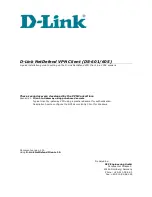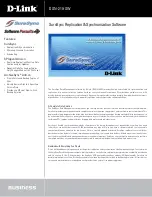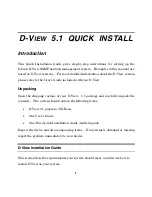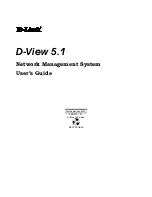
Volume 2, Part 2: Firmware Overview
2:631
the EfiExitBootServices() procedure. After this call, UEFI boot services may no longer
be invoked by the OS. The UEFI runtime services execute in physical mode until the OS
invokes the EFISetVirtualAddress() function to switch the UEFI to virtual mode. After
this point, the UEFI runtime services may be invoked in virtual mode only. For full
information on all the UEFI boot and runtime services please refer to the UEFI
specification [UEFI].
13.2.4
ACPI Control Methods
Advanced Configuration and Power Interface (ACPI) firmware provides a method of
reporting system resources (up to the boundary of the box) to the operating systems.
ACPI uses tables to describe system information, features, and methods for controlling
those features. The ACPI tables list devices on the system board, devices that cannot
be detected by bus walks, and devices which require the OS for power or temperature
management. The ACPI control methods use a pseudo-code language called AML (ACPI
Machine Language). AML is a tokenized language. The OS contains and uses an AML
interpreter that interprets and executes these methods stored in the ACPI tables.
13.2.5
Physical and Virtual Addressing Mode Considerations
All of the PAL procedures can be called in the physical addressing mode. A subset of PAL
calls can be made using the virtual addressing mode. For PAL calls that can be invoked
using virtual addressing mode, it is the responsibility of the caller to map these PAL
procedures with an ITR as well as either a DTR or DTC. If the caller chooses to map the
PAL procedures using a DTC it must be able to handle TLB faults that could occur. See
Section 11.10.1, “PAL Procedure Summary”
for a summary of all PAL procedures and
the calling conventions.
The SAL and UEFI firmware layers have been designed to operate in virtual addressing
mode. UEFI provides an interface to the OS loader that describes the physical memory
addresses used by firmware and indicates whether the virtual address of such areas
need to be registered by the OS with UEFI. The UEFI Specification [UEFI] also provides
the interfaces for the OS to register the virtual address mappings. In a MP
configuration, the virtual addresses registered by the OS must be valid globally on all
the processors in the system.
The SAL runtime services may be called either in virtual or physical addressing mode.
SAL procedures that execute during machine check, INIT, and PMI handling must be
invoked in physical addressing mode.
The parameters passed to the firmware runtime services must be consistent with the
addressing environment, i.e. PSR.dt, PSR.rt setting. Additionally, the global pointer
(gp) register [SWC] must contain the physical or virtual address for use by the
firmware.
13.2.5.1
SAL Procedures that Invoke PAL Procedures
Some of the SAL runtime services, e.g. SAL_CACHE_FLUSH, will need to invoke PAL
procedures. While invoking these SAL procedures in virtual mode, the OS must provide
the appropriate translation resources required by PAL (i.e. ITR and DTC covering the
PAL code area).
Summary of Contents for ITANIUM ARCHITECTURE - SOFTWARE DEVELOPERS VOLUME 3 REV 2.3
Page 1: ......
Page 11: ...x Intel Itanium Architecture Software Developer s Manual Rev 2 3 ...
Page 13: ...1 2 Intel Itanium Architecture Software Developer s Manual Rev 2 3 ...
Page 33: ...1 22 Volume 1 Part 1 Introduction to the Intel Itanium Architecture ...
Page 57: ...1 46 Volume 1 Part 1 Execution Environment ...
Page 147: ...1 136 Intel Itanium Architecture Software Developer s Manual Rev 2 3 ...
Page 149: ...1 138 Volume 1 Part 2 About the Optimization Guide ...
Page 191: ...1 180 Volume 1 Part 2 Predication Control Flow and Instruction Stream ...
Page 230: ......
Page 248: ...236 Intel Itanium Architecture Software Developer s Manual Rev 2 3 ...
Page 250: ...2 2 Intel Itanium Architecture Software Developer s Manual Rev 2 3 ...
Page 264: ...2 16 Volume 2 Part 1 Intel Itanium System Environment ...
Page 380: ...2 132 Volume 2 Part 1 Interruptions ...
Page 398: ...2 150 Volume 2 Part 1 Register Stack Engine ...
Page 486: ...2 238 Volume 2 Part 1 IA 32 Interruption Vector Descriptions ...
Page 750: ...2 502 Intel Itanium Architecture Software Developer s Manual Rev 2 3 ...
Page 754: ...2 506 Volume 2 Part 2 About the System Programmer s Guide ...
Page 796: ...2 548 Volume 2 Part 2 Interruptions and Serialization ...
Page 808: ...2 560 Volume 2 Part 2 Context Management ...
Page 842: ...2 594 Volume 2 Part 2 Floating point System Software ...
Page 850: ...2 602 Volume 2 Part 2 IA 32 Application Support ...
Page 862: ...2 614 Volume 2 Part 2 External Interrupt Architecture ...
Page 870: ...2 622 Volume 2 Part 2 Performance Monitoring Support ...
Page 891: ......
Page 1099: ...3 200 Volume 3 Instruction Reference padd Interruptions Illegal Operation fault ...
Page 1295: ...3 396 Volume 3 Resource and Dependency Semantics ...
Page 1296: ......
Page 1302: ...402 Intel Itanium Architecture Software Developer s Manual Rev 2 3 ...
Page 1494: ...4 192 Volume 4 Base IA 32 Instruction Reference FWAIT Wait See entry for WAIT ...
Page 1647: ...Volume 4 Base IA 32 Instruction Reference 4 345 ROL ROR Rotate See entry for RCL RCR ROL ROR ...
Page 1884: ...4 582 Volume 4 IA 32 SSE Instruction Reference ...
Page 1885: ...Index Intel Itanium Architecture Software Developer s Manual Rev 2 3 Index ...
Page 1886: ...Index Intel Itanium Architecture Software Developer s Manual Rev 2 3 ...
Page 1898: ...INDEX Index 12 Index for Volumes 1 2 3 and 4 ...
















































